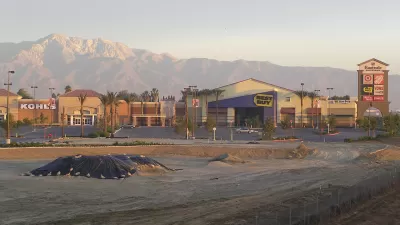Canceled projects, price discounts, and increased incentives to buyers are already showing up in real estate developments in key U.S. regions, writes estate and affordable housing adviser Michael P. Russell. He reviews some key indicators.

California's real estate market has been on fire, outperforming the rest of the nation and the economy in general. But it won't last much longer, writes real estate and affordable housing adviser Michael P. Russell:
The retail sector is experiencing the following:
- Core retail sales advanced 4.3% in the past year.
- An increase in e-commerce.
- Declining consumer income
- Consolidation of various categories (i.e. sporting goods, department stores)
- Tenant location decisions are often based upon rental rate
In the housing sector:
In January, U. S. home prices climbed at more than double the rate of incomes, a trend that could ultimately create affordability challenges for buyers and extend the time that homes stay on the market. The Standard & Poor’s/Case-Shiller 20 city home price index rose 5.7% from a year earlier. In Los Angeles and Orange counties, home prices jumped 6.9% from a year earlier.
Nationally, monthly rent growth for apartment REITs have slowed to 4.1% year over year in March from 4.2% in February. Markets that are showing signs of deceleration include Boston, Dallas, Orlando, San Diego and Silver Spring, Maryland. At the same time, MPF Research, a national apartment research firm reports that 55.1% of renters chose to renew their lease, which is the highest renewal rate in ten years. In 111 markets, apartment rents reached a new peak in February, climbing an average of $7 to $1,175.Given these factors, homebuilders and apartment developers have cut multifamily and single-family construction more than expected in March, declining 8.8% overall from February. In February, the West entirely powered the sales numbers.
Ultimately, real estate market health depends on job and real income growth: "From 2005 to 2014, real income growth declined by 4.28 percent." Citigroup, Inc. warns that the chances for a global recession "are already high and only going to go up," writes Russell—and that was before BREXIT.
In the main article, Russell goes on to make predictions about how this will impact on public sector planning.
FULL STORY: The Hissing Sound and the U. S. Real Estate Market

Alabama: Trump Terminates Settlements for Black Communities Harmed By Raw Sewage
Trump deemed the landmark civil rights agreement “illegal DEI and environmental justice policy.”

Planetizen Federal Action Tracker
A weekly monitor of how Trump’s orders and actions are impacting planners and planning in America.

Why Should We Subsidize Public Transportation?
Many public transit agencies face financial stress due to rising costs, declining fare revenue, and declining subsidies. Transit advocates must provide a strong business case for increasing public transit funding.

Understanding Road Diets
An explainer from Momentum highlights the advantages of reducing vehicle lanes in favor of more bike, transit, and pedestrian infrastructure.

New California Law Regulates Warehouse Pollution
A new law tightens building and emissions regulations for large distribution warehouses to mitigate air pollution and traffic in surrounding communities.

Phoenix Announces Opening Date for Light Rail Extension
The South Central extension will connect South Phoenix to downtown and other major hubs starting on June 7.
Urban Design for Planners 1: Software Tools
This six-course series explores essential urban design concepts using open source software and equips planners with the tools they need to participate fully in the urban design process.
Planning for Universal Design
Learn the tools for implementing Universal Design in planning regulations.
Caltrans
Smith Gee Studio
Institute for Housing and Urban Development Studies (IHS)
City of Grandview
Harvard GSD Executive Education
Toledo-Lucas County Plan Commissions
Salt Lake City
NYU Wagner Graduate School of Public Service





























